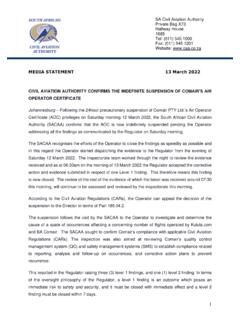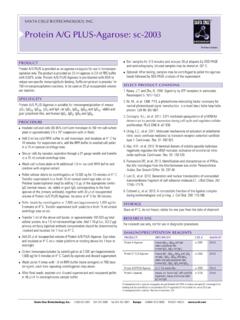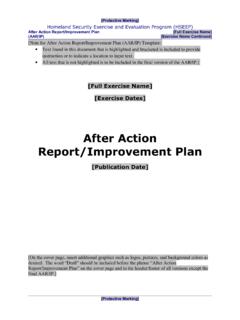Transcription of ANNEX I SUMMARY OF PRODUCT CHARACTERISTICS
1 1 ANNEX I SUMMARY OF PRODUCT CHARACTERISTICS 2 This medicinal PRODUCT is subject to additional monitoring. This will allow quick identification of new safety information. Healthcare professionals are asked to report any suspected adverse reactions. See section for how to report adverse reactions. 1. NAME OF THE MEDICINAL PRODUCT Shingrix powder and suspension for suspension for injection Herpes zoster vaccine (recombinant, adjuvanted) 2. QUALITATIVE AND QUANTITATIVE COMPOSITION After reconstitution, one dose ( mL) contains: Varicella Zoster Virus1 g lycoprotein E antigen2,3 50 micrograms 1 Varicella Zoster Virus = VZV 2 adjuvanted with AS01B containing: plant extract Quillaja saponaria Molina, fraction 21 (QS-21) 50 micrograms 3- O-desacyl-4 -monophosphoryl lipid A (MPL) from Salmonella minnesota 50 micrograms 3 glycoprotein E (gE) produced in Chinese Hamster Ovary (CHO) cells by recombinant DNA technology For the full list of excipients, see section 3.
2 PHARMACEUTICAL FORM Powder and suspension for suspension for injection. The powder is white. The suspension is an opalescent, colourless to pale brownish liquid. 4. CLINICAL PARTICULARS Therapeutic indications Shingrix is indicated for prevention of herpes zoster (HZ) and post-herpetic neuralgia (PHN), in: adults 50 years of age or older; adults 18 years of age or older at increased risk of HZ. The use of Shingrix should be in accordance with official recommendations. Posology and method of administration Posology The primary vaccination schedule consists of two doses of mL each: an initial dose followed by a second dose 2 months later. If flexibility in the vaccination schedule is necessary, the second dose can be administered between 2 and 6 months after the first dose (see section ). For subjects who are or might become immunodeficient or immunosuppressed due to disease or therapy, and whom would benefit from a shorter vaccination schedule, the second dose can be given 1 to 2 months after the initial dose (see section ).
3 3 The need for booster doses following the primary vaccination schedule has not been established (see section ). Shingrix can be given with the same schedule in individuals previously vaccinated with live attenuated HZ vaccine (see section ). Shingrix is not indicated for prevention of primary varicella infection (chickenpox). Paediatric population The safety and efficacy of Shingrix in children and adolescents have not been established. No data are available. Method of administration For intramuscular injection only, preferably in the deltoid muscle. For instructions on reconstitution of the medicinal PRODUCT before administration, see section Contraindications Hypersensitivity to the active substances or to any of the excipients listed in section Special warnings and precautions for use Prior to immunisation As with all injectable vaccines, appropriate medical treatment and supervision should always be readily available in case of an anaphylactic event following the administration of the vaccine.
4 As with other vaccines, vaccination with Shingrix should be postponed in subjects suffering from an acute severe febrile illness. However, the presence of a minor infection, such as a cold, should not result in the deferral of vaccination. As with any vaccine, a protective immune response may not be elicited in all vaccinees. The vaccine is for prophylactic use only and is not intended for treatment of established clinical disease. Do not administer the vaccine intravascularly or intradermally. Subcutaneous administration is not recommended. Maladministration via the subcutaneous route may lead to an increase in transient local reactions. Shingrix should be given with caution to individuals with thrombocytopenia or any coagulation disorder since bleeding may occur following intramuscular administration to these subjects. Syncope (fainting) can occur following, or even before, any vaccination as a psychogenic response to the needle injection.
5 This can be accompanied by several neurological signs such as transient visual disturbance, paraesthesia and tonic-clonic limb movements during recovery. It is important that procedures are in place to avoid injury from faints. In a post-marketing observational study in individuals aged 65 years or older, an increased risk of Guillain-Barr syndrome (estimated 3 excess cases per million doses administered) was observed during the 42 days following vaccination with Shingrix. Available information is insufficient to determine a causal relationship with Shingrix. 4 There are no safety, immunogenicity or efficacy data to support replacing a dose of Shingrix with a dose of another HZ vaccine. There are limited data to support the use of Shingrix in individuals with a history of HZ (see section ). Healthcare professionals therefore need to weigh the benefits and risks of HZ vaccination on an individual basis.
6 Excipients This medicine contains less than 1 mmol sodium (23 mg) per dose, that is to say essentially sodium-free . This medicine contains potassium, less than 1 mmol (39 mg) per dose, essentially potassium-free . Traceability In order to improve the traceability of biological medicinal products, the name and the batch number of the administered PRODUCT should be clearly recorded. Interaction with other medicinal products and other forms of interaction Shingrix can be given concomitantly with unadjuvanted inactivated seasonal influenza vaccine, 23-valent pneumococcal polysaccharide vaccine (PPV23) or reduced antigen diphtheria-tetanus-acellular pertussis vaccine (dTpa). The vaccines should be administered at different injection sites. In three phase III, controlled, open-label clinical studies, adults 50 years of age were randomised to receive 2 doses of Shingrix 2 months apart administered either concomitantly at the first dose or non-concomitantly with an unadjuvanted inactivated seasonal influenza vaccine (N=828; Zoster-004), a PPV23 vaccine (N=865; Zoster-035) or a dTpa vaccine formulated with milligrams Al3+ (N=830; Zoster-042).
7 The immune responses of the co-administered vaccines were unaffected, with the exception of lower geometric mean concentrations (GMCs) for one of the pertussis antigens (pertactin) when Shingrix is co-administered with the dTpa vaccine. The clinical relevance of this data is not known. The adverse reactions of fever and shivering were more frequent when PPV23 vaccine is co-administered with Shingrix. Concomitant use with other vaccines is not recommended due to lack of data. Fertility, pregnancy and lactation Pregnancy There are no data from the use of Shingrix in pregnant women. Animal studies do not indicate direct or indirect harmful effects with respect to pregnancy, embryonal/foetal development, parturition or post-natal development (see section ). As a precautionary measure, it is preferable to avoid the use of Shingrix during pregnancy. Breast-feeding The effect on breast-fed infants of administration of Shingrix to their mothers has not been studied.
8 It is unknown whether Shingrix is excreted in human milk. Fertility 5 Animal studies do not indicate direct or indirect effects with respect to fertility in males or females (see section ). Effects on ability to drive and use machines No studies on the effects of Shingrix on the ability to drive and use machines have been performed. Shingrix may have a minor influence on the ability to drive and use machines in the 2-3 days following vaccination. Fatigue and malaise may occur following administration (see section ). Undesirable effects SUMMARY of the safety profile In adults aged 50 years and above, the most frequently reported adverse reactions were pain at the injection site ( overall/dose; severe/dose), myalgia ( overall/dose; severe/dose), fatigue ( overall/dose; severe/dose) and headache ( overall/dose; severe/dose). Most of these reactions were not long-lasting (median duration of 2 to 3 days).
9 Reactions reported as severe lasted 1 to 2 days. In adults 18 years of age who are immunodeficient or immunosuppressed due to disease or therapy (referred to as immunocompromised (IC)), the safety profile was consistent with that observed in adults 50 years and above. There are limited data in adults aged 18-49 years at increased risk of HZ who are not IC. Overall, there was a higher incidence of some adverse reactions in younger age groups: - studies in IC adults 18 years of age (pooled analysis): the incidence of pain at the injection site, fatigue, myalgia, headache, shivering and fever was higher in adults aged 18-49 years compared to those aged 50 years and above. - studies in adults 50 years of age (pooled analysis): the incidence of myalgia, fatigue, headache, shivering, fever and gastrointestinal symptoms was higher in adults aged 50-69 years compared to those aged 70 years and above.
10 Tabulated list of adverse reactions The safety profile presented below is based on a pooled analysis of data generated in placebo-controlled clinical studies on 5,887 adults 50-69 years of age and 8,758 adults 70 years of age. In clinical studies in IC adults 18 years of age (1,587 subjects) the safety profile is consistent with the data presented in the Table below. Adverse reactions reported during post-marketing surveillance are also tabulated below. Adverse reactions reported are listed according to the following frequency: Very common ( 1/10) Common ( 1/100 to <1/10) Uncommon ( 1/1,000 to <1/100) Rare ( 1/10,000 to <1/1,000) Very rare (<1/10,000) Within each frequency grouping the adverse reactions are reported in the order of decreasing seriousness. 6 System Organ Class1 Frequency Adverse reactions Blood and lymphatic system disorders Uncommon lymphadenopathy Immune system disorders Rare hypersensitivity reactions including rash, urticaria, angioedema2 Nervous system disorders Very common headache Gastrointestinal disorders Very common gastrointestinal symptoms (including nausea, vomiting, diarrhoea and/or abdominal pain) Musculoskeletal and connective tissue disorders Very common myalgia Uncommon arthralgia General disorders and administration site conditions Very common injection site reactions (such as pain, redness, swelling), fatigue, chills, fever Common injection site pruritus, malaise 1 According to MedDRA (medical dictionary for regulatory activities)














